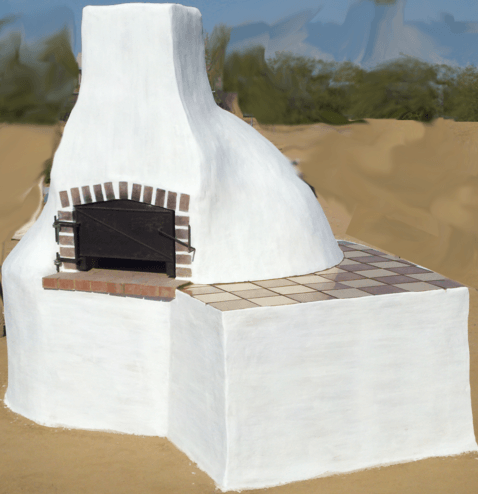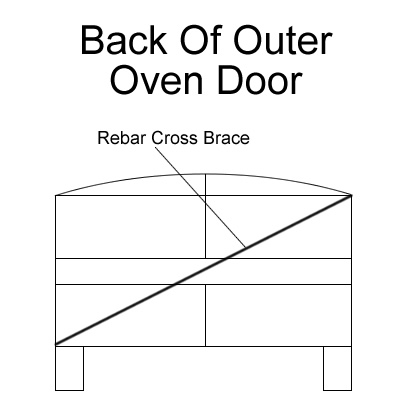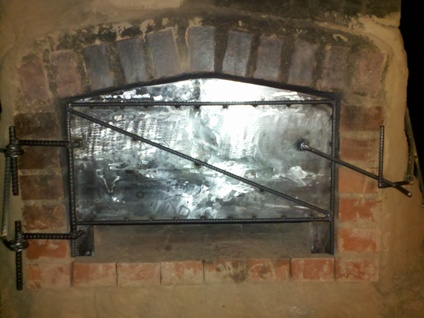Alright I said that in this post I would go into all of the fabrication details, the math and my mounting system for the outer oven door. The first thing that I had to do was to figure out the math that would tell me how large of an air gap would be needed. I based my calculations on what I could find from the rocket stoves. I figured out that the optimal air gap was between 20% – 23% of the height of the door. So my 17 inch tall door needed a 3.4 to 3.91 inch air gap. Armed with this knowledge I settled on 3.5 inches for the air gap and then set off to find the materials to build the door.
I knew that wood wasn’t going to work well so I had to look at using metal. I dug all through my stash and found 5 mild steel plates, 1 mild steel strip and some 1/2 inch rebar. I also bought 3 20 foot pieces of 3/8 inch rebar for about $11.00. I measured it all out and laid out the pieces and found that I had just enough steel for the door. I split one steel plate lengthwise for the top of the door that I trimmed to fit the curve of the arch.

In the picture you can see how I laid out all of the steel pieces. I cut the steel strip and used the leftover pieces for the bottom legs. I used an angle grinder to grind down the edges of all the steel plates so there was space for the weld beads. I then welded all of the pieces together and ground down all of the weld beads on the front and back so I had a nice fairly contiguous surface on both sides. Now any of you that have done any welding know that when you take multiple pieces and weld them together they like to twist and buckle. So as you can see in the picture above I added a frame of 3/8 inch rebar and a cross brace to help remove some twisting.
As you can see from the picture of the back of the door I also added a cross brace going the opposite direction of the one on the front side of the door. This was to help remove the rest of the twist from welding the pieces together.
OK so why am I showing this picture? Well this is for several reasons. The first is that I’ve seen a lot of people try to weld metal pieces by pressing the edges together and then running a bead of weld on top. However when they grind down the weld bead the pieces fall apart easily. By grinding the edges down it allows the weld bead to become part of the metal plate so when you grind down the top to make it smooth the joint stays strong and solid. This makes for a much stronger and longer lasting door.
My second reason is that by beveling the edges of the plates and then running your welding bead in the groove more weld is in contact with the metal plates so that when you grind the bead smooth you will remove a lot less metal. So you waste a lot less which also makes the process cheaper because welding wire is not cheap.
The third reason for this is there is much less welding needed to fill any gaps on the back side of the panel after the front side side welded up. Which again saves on welding wire and means less material has to be removed to smooth out the surface of the door.
Now as you can see once put together you can hardly notice all of the individual pieces of steel. OK now let me be honest here, it took me several days to do this and when I was done at the end of each day I was hurting bad and I was exhausted but, it was worth it in the end. I just want to warn you that if you go this route that the little hand grinders are deceiving. The amount of torque they produce in conjunction with the angles you have to use them at really wears you down. So I know how long it took me to do this and how much it hurt to do but, since part of the goal of this project was to spend as little money as possible I used what I had.
One more point about the picture above. You’ll notice that I did not weld the rebar frame to the metal plate the same way. Due to the heating and cooling of the door I wanted to allow the door to expand and contract without breaking the welds holding the frame on to the steel plate. By spacing out the welds attaching the frame to the steel plate it does just that. This makes for a much longer life span of the door with fewer problems or repairs down the road.
Alright yes, I know that I had said I wanted the door to look like the old cast iron doors. Well it will as you use the oven. I looked up how the cast iron doors were treated to prevent rusting. The simple answer was oil. The very same way cast iron pots and pans are seasoned. Oil is used to create a carbon layer on the metal giving it that distinct black color. Over the years everything from lard to vegetable oils has been used for this. I settled on olive oil since that’s what I had. As I’ve used the oven the door has darkened considerably. I coated the front and back of the door as well as all of the exposed rebar with the olive oil right before I fired the oven for four times. After that it will get darker as time goes on and should only need to be coated about once a year.


As you can see from the the pictures above the door does begin to get darker and take on that traditional look of the cast iron in a fairly short amount of time. OK I should point out also that on the backside of the door I did have to add one more piece of rebar to the top section of the door. This was to stop the top of the door from curving backward. The problem didn’t show up until after the first firing.
I’ll describe how I hung the door and keep it closed in the next post so this one won’t be to long.







